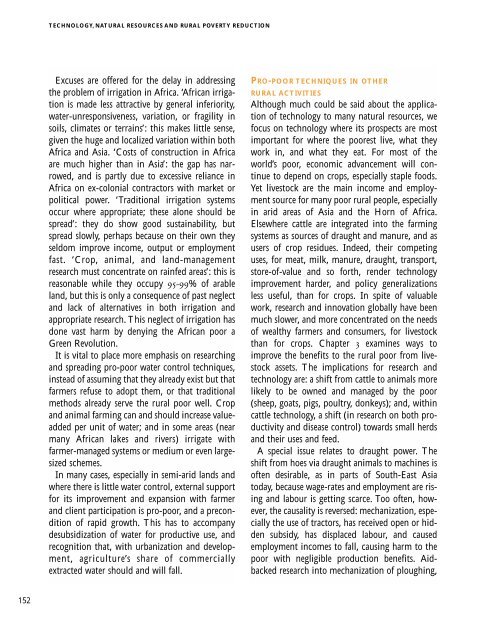English - IFAD
English - IFAD
English - IFAD
Create successful ePaper yourself
Turn your PDF publications into a flip-book with our unique Google optimized e-Paper software.
TECHNOLOGY, NATURAL RESOURCES AND RURAL POVERTY REDUCTION<br />
Excuses are offered for the delay in addressing<br />
the problem of irrigation in Africa. ‘African irrigation<br />
is made less attractive by general inferiority,<br />
water-unresponsiveness, variation, or fragility in<br />
soils, climates or terrains’: this makes little sense,<br />
given the huge and localized variation within both<br />
Africa and Asia. ‘Costs of construction in Africa<br />
are much higher than in Asia’: the gap has narrowed,<br />
and is partly due to excessive reliance in<br />
Africa on ex-colonial contractors with market or<br />
political power. ‘Traditional irrigation systems<br />
occur where appropriate; these alone should be<br />
spread’: they do show good sustainability, but<br />
spread slowly, perhaps because on their own they<br />
seldom improve income, output or employment<br />
fast. ‘Crop, animal, and land-management<br />
research must concentrate on rainfed areas’: this is<br />
reasonable while they occupy 95-99% of arable<br />
land, but this is only a consequence of past neglect<br />
and lack of alternatives in both irrigation and<br />
appropriate research. This neglect of irrigation has<br />
done vast harm by denying the African poor a<br />
Green Revolution.<br />
It is vital to place more emphasis on researching<br />
and spreading pro-poor water control techniques,<br />
instead of assuming that they already exist but that<br />
farmers refuse to adopt them, or that traditional<br />
methods already serve the rural poor well. Crop<br />
and animal farming can and should increase valueadded<br />
per unit of water; and in some areas (near<br />
many African lakes and rivers) irrigate with<br />
farmer-managed systems or medium or even largesized<br />
schemes.<br />
In many cases, especially in semi-arid lands and<br />
where there is little water control, external support<br />
for its improvement and expansion with farmer<br />
and client participation is pro-poor, and a precondition<br />
of rapid growth. This has to accompany<br />
desubsidization of water for productive use, and<br />
recognition that, with urbanization and development,<br />
agriculture’s share of commercially<br />
extracted water should and will fall.<br />
PRO-POOR TECHNIQUES IN OTHER<br />
RURAL ACTIVITIES<br />
Although much could be said about the application<br />
of technology to many natural resources, we<br />
focus on technology where its prospects are most<br />
important for where the poorest live, what they<br />
work in, and what they eat. For most of the<br />
world’s poor, economic advancement will continue<br />
to depend on crops, especially staple foods.<br />
Yet livestock are the main income and employment<br />
source for many poor rural people, especially<br />
in arid areas of Asia and the Horn of Africa.<br />
Elsewhere cattle are integrated into the farming<br />
systems as sources of draught and manure, and as<br />
users of crop residues. Indeed, their competing<br />
uses, for meat, milk, manure, draught, transport,<br />
store-of-value and so forth, render technology<br />
improvement harder, and policy generalizations<br />
less useful, than for crops. In spite of valuable<br />
work, research and innovation globally have been<br />
much slower, and more concentrated on the needs<br />
of wealthy farmers and consumers, for livestock<br />
than for crops. Chapter 3 examines ways to<br />
improve the benefits to the rural poor from livestock<br />
assets. The implications for research and<br />
technology are: a shift from cattle to animals more<br />
likely to be owned and managed by the poor<br />
(sheep, goats, pigs, poultry, donkeys); and, within<br />
cattle technology, a shift (in research on both productivity<br />
and disease control) towards small herds<br />
and their uses and feed.<br />
A special issue relates to draught power. The<br />
shift from hoes via draught animals to machines is<br />
often desirable, as in parts of South-East Asia<br />
today, because wage-rates and employment are rising<br />
and labour is getting scarce. Too often, however,<br />
the causality is reversed: mechanization, especially<br />
the use of tractors, has received open or hidden<br />
subsidy, has displaced labour, and caused<br />
employment incomes to fall, causing harm to the<br />
poor with negligible production benefits. Aidbacked<br />
research into mechanization of ploughing,<br />
152
















